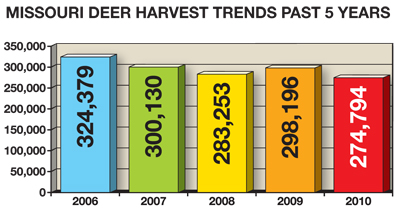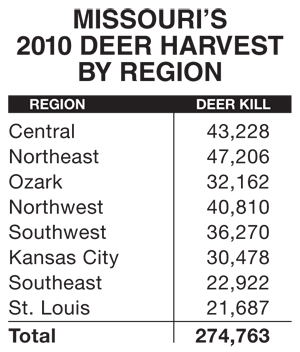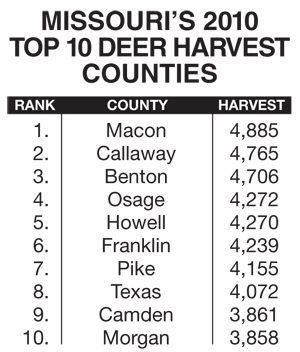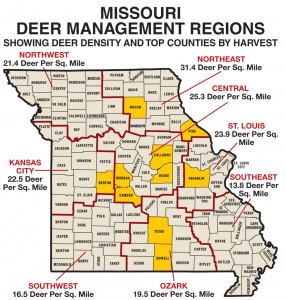Acorn shortage leads to rise in deer taken in Mo. firearms season--204,000 Deer killed during 11 day hunt
stltoday.com
The Missouri Department of Conservation reported the deer harvest, which ran from Nov. 10 through Nov. 20, was strong in the southern part of the state but lower than normal in the north. Three people were killed in firearm-hunting incidents, and five people were injured.
Jim Low, a communication specialist with the Conservation Department, said the state and regional harvest figures mirrored a preseason forecast by resource scientist Jason Sumners, who predicted a poor acorn crop in southern Missouri would drive the numbers up.
Southern Missouri is heavily forested, so acorns are a large part of deer diets in the fall and winter. When acorns are scarce, deer are forced to move around more and they gather near food sources, making them easier for hunters to find.
Whitetails
The 204,668 deer shot during the firearms season were 7.7 percent more than last year but slightly below the 10-year average. Low said eight of the top 10 harvest counties were south of the Missouri River, and a ninth borders the river.
The decline in harvest numbers in the northern part of the state reflects a decline in the deer population over the past 10 years, Sumners said, while numbers are slowly rising in the south. Both of those trends are the result of conservation department efforts to maximize hunting opportunities while avoiding unacceptably high levels of property damage and deer-related auto accidents, he said.
Dave Carlisle, a conservation agent based in Buchanan County north of Kansas City, told the St. Joseph News-Press that fair weather had a negative impact on the deer hunt in the northern part of the state. Deer move around more in colder weather, he said, and are more accessible to hunters.
Carlisle said drought conditions led to hemorrhagic disease, or "bluetongue," which thinned the population in some areas, while a third factor might be that hunters are finally stabilizing the region's large deer population.
"In all sincerity, I think with our antlerless harvest, we're finally leveling off and dipping into the herd," Carlisle said. "If you're someone who has hit two deer in your car, you'll say we have too many deer. If you're the hunter who hasn't shot anything in two years, you'll probably say we don't have enough."
Conservation officials said deer hunting contributes about $1 billion annually to state and local economies and supports more than 12,000 jobs in the state.
-----------------------------------------------------------------------------------------------------------------------
MISSOURI DEER DENSITIES
gameandfishmagazine.com
Deer hunters in the Show Me State are blessed with an abundance of whitetails and a whole lot of area to hunt them in. Missouri has 68,512 square-miles of space for the deer to roam. Take away cities, suburbs and towns and that area is significantly less. However, based on the entire 68,512 square-miles and a whitetail herd that is estimated to be 1.4 to 1.5 million large, that equals an average of about 21 deer per square mile!



SUMMARY
Missouri’s deer herd remains stable; hunters with a little know-how can go just about anywhere in the state and fill at least one tag. The variables that determine harvest numbers nowadays are mast production, weather and deer disease. Of course, none of these X-factors are predictable, but things are looking good for this fall’s deer seasons.
“Overall, I expect to see a slight increase in harvest this year,” Hansen predicted. “I believe that for the most part, deer harvest in northern Missouri will be about the same, while hunters in the Ozarks will take more deer this year.”
Jim Low, a communication specialist with the Conservation Department, said the state and regional harvest figures mirrored a preseason forecast by resource scientist Jason Sumners, who predicted a poor acorn crop in southern Missouri would drive the numbers up.
Southern Missouri is heavily forested, so acorns are a large part of deer diets in the fall and winter. When acorns are scarce, deer are forced to move around more and they gather near food sources, making them easier for hunters to find.
Whitetails
The 204,668 deer shot during the firearms season were 7.7 percent more than last year but slightly below the 10-year average. Low said eight of the top 10 harvest counties were south of the Missouri River, and a ninth borders the river.
The decline in harvest numbers in the northern part of the state reflects a decline in the deer population over the past 10 years, Sumners said, while numbers are slowly rising in the south. Both of those trends are the result of conservation department efforts to maximize hunting opportunities while avoiding unacceptably high levels of property damage and deer-related auto accidents, he said.
Dave Carlisle, a conservation agent based in Buchanan County north of Kansas City, told the St. Joseph News-Press that fair weather had a negative impact on the deer hunt in the northern part of the state. Deer move around more in colder weather, he said, and are more accessible to hunters.
Carlisle said drought conditions led to hemorrhagic disease, or "bluetongue," which thinned the population in some areas, while a third factor might be that hunters are finally stabilizing the region's large deer population.
"In all sincerity, I think with our antlerless harvest, we're finally leveling off and dipping into the herd," Carlisle said. "If you're someone who has hit two deer in your car, you'll say we have too many deer. If you're the hunter who hasn't shot anything in two years, you'll probably say we don't have enough."
Conservation officials said deer hunting contributes about $1 billion annually to state and local economies and supports more than 12,000 jobs in the state.
-----------------------------------------------------------------------------------------------------------------------
MISSOURI DEER DENSITIES
gameandfishmagazine.com
Deer hunters in the Show Me State are blessed with an abundance of whitetails and a whole lot of area to hunt them in. Missouri has 68,512 square-miles of space for the deer to roam. Take away cities, suburbs and towns and that area is significantly less. However, based on the entire 68,512 square-miles and a whitetail herd that is estimated to be 1.4 to 1.5 million large, that equals an average of about 21 deer per square mile!



SUMMARY
Missouri’s deer herd remains stable; hunters with a little know-how can go just about anywhere in the state and fill at least one tag. The variables that determine harvest numbers nowadays are mast production, weather and deer disease. Of course, none of these X-factors are predictable, but things are looking good for this fall’s deer seasons.
“Overall, I expect to see a slight increase in harvest this year,” Hansen predicted. “I believe that for the most part, deer harvest in northern Missouri will be about the same, while hunters in the Ozarks will take more deer this year.”












No comments:
Post a Comment